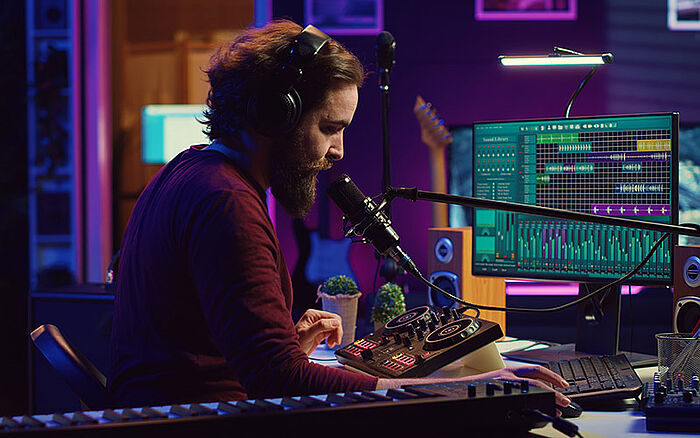
World IP Day: Feel the beat of rights, royalties and innovation
Before a song finds its way into our ears, it begins quietly: a stray thought, a scribbled lyric, a single chord played in a moment of instinct. That small creative spark takes shape through effort and intuition, eventually becoming something that moves people across languages and borders.
What often goes unnoticed is the legal structure that supports this process. Intellectual Property (IP) rights operate behind the scenes, giving artists and producers the security to release their work and the recognition to sustain it. This year, for World IP Day, we are invited to "Feel the Beat of IP" and explore the role this framework plays in the way music is made, shared and valued as technology continues to shift the rhythm of an entire industry.
Ownership battles: the artist vs. the industry
Creators breathe life into the music we love — but who owns the identities behind the tunes? Artists often cultivate personal brands that represent their appearance, values, creative style and more. While the concept of a "personal brand" is complicated and occasionally controversial, one thing is clear: The narrative we construct around ourselves remains our own, for better and for worse. Artists bring their brands with them when they switch genres, record labels and even disciplines. This means a label can shield itself from a creator's negative public relations or deflect criticism that may result from IP missteps, such as when Vanilla Ice allegedly copied the bass line for "Ice Ice Baby." The other side of the coin is that the brand value associated with big stars can slip through a label's fingers when ways part.
In most cases, what labels do own is the recordings. Musicians often sell full or partial rights to record labels; in exchange, the creators generally get royalties, distribution and the benefit of industry connections. However, along with the rights, they also give up a significant amount of control.

While musicians pour identity and intent into their work, once a recording contract is signed, it is often the licensing terms – and not the creative process – that determine who reaps what proportion of the financial rewards.
One famous example of this is Taylor Swift's rereleasing albums. Between 2005 and 2018, the artist was signed with Big Machine Records, which owned the original recordings, or "masters," of her first six albums. When she signed on with Universal's Republic Records, she made sure to secure IP ownership of all future masters for herself and rerecorded the six earlier albums to reclaim control over every lyric, beat and rhythm — all pointedly titled with "(Taylor's Version)." This shook the music industry, but it was possible because, although Big Machine Records held the reproduction- and distribution rights to the original masters, Taylor Swift, as the songwriter, maintained the copyrights to the compositions themselves and could record and perform them as she pleased (following a three-year post-contract period). With the newer versions becoming much more popular and, consequently, more valuable, Taylor Swift has created an interesting overlap between her evolving personal brand and her art, which has proved to be inherently altered by its IP ownership.
Cash flows: revenue in the age of streaming
However, these ownership battles are not just between artists and labels anymore; today, entities like Spotify and YouTube are part of the money chain. Hence, streaming services often put all subscription earnings into a single pot and distribute them based on each copyright holder's percentage of total streams. Now that the music industry at large has recognized the many questions this system presents, multiple countries have looked to legislation to help clarify who gets paid what and when:
- The French recording industry established a minimum payment based on the number of streams
- The United States Music Modernization Act created new processes to ensure rightsholders get royalties when their work is streamed
- Though not in place, a United Kingdom Parliamentary committee has recommended new approaches to artist royalties

The rise of streaming has created a royalty ecosystem that is anything but straightforward. Payments often depend on cumulative platform data rather than individual song value, prompting efforts to reshape outdated revenue frameworks and address long-standing disparities in creative compensation.
Of course, these rules must operate alongside existing copyright laws, which makes things more complex. A song and the rights to distribute it are not always treated the same, as illustrated by the example of Taylor Swift, where recordings and compositions were handled separately. The situation becomes even more nuanced when multiple artists collaborate on a single track.
In such cases, each contributor or label may hold rights to the jointly created work but is typically entitled only to a share of the revenue it earns. Ownership does not automatically mean control over the whole. Music and lyric rights are often managed together, although they can be split or assigned independently, depending on the agreements in place.
One song, many hands and many rights
It is not always obvious which contributions to a musical work qualify for IP rights and which do not. Courts often ask whether an individual element — a lyric, a melody or a beat — would be copyrightable. If it does, the contributor may have a claim to shared authorship. If not, their involvement may not be recognized as legally meaningful.
The height of this involution can be found in remixes, where the question of ownership may lead to cases like Arty vs. Marshmello. Simply put, U.S. pop rock band OneRepublic wrote a song, "I Lived," and Russian DJ Arty signed an agreement to remix it. Later, Arty claimed a fellow DJ, Marshmello, infringed on his remix's copyright — raising the question: Who held the rights to the remixed song? Arty had signed an agreement saying he would not own "the underlying musical composition(s)," and lawyers debated whether that meant the original song or the remixed version. Ultimately, a U.S. District judge ruled the contract was an unambiguous waiver of "any ownership or financial interest" in the remix and dismissed the claim, with the U.S. Court of Appeals for the Ninth Circuit upholding the decision the following year.

Remixes often exist in a legal gray zone where authorship and contractual language collide. Without precise definitions, creative contributions risk being excluded from ownership as courts prioritize the exact wording of remix agreements over artistic intent.
These battles are difficult enough when human artists are involved, but they become really knotty when artificial intelligence (AI) enters the recording studio.
The future of music ownership: AI and digital evolution
Can AI-generated music be copyrighted? A recent U.S. court ruling on AI-generated art makes the answer clear: Without human authorship, there can be no copyright protection. In the music industry, a high-profile imitation of Drake and The Weeknd led to the removal of an AI-generated song from streaming platforms — not because it lacked a human creator, but because it was produced using an AI model trained on copyrighted works. These examples mark only the beginning of a much broader confrontation between AI and IP law.
Not everything is black and white, however. In a recent report, the United States Copyright Office acknowledged a crucial distinction between AI-created work and AI-assisted work. It noted that while complementary uses do not limit copyright protection for human-created elements, "expressive choices" by AI systems require deeper scrutiny.
This leaves today's artists with two weighty dilemmas. The first is how they will approach the creative process in an era where some technology utilizations can limit copyrightability. They may find themselves questioning what art is, what an artist is and how these definitions will change as AI develops. The second problem is how creators will protect themselves and their art from AI-enabled infringement. Counterfeiting has long been an IP concern, but now it has taken a new form that can appear at the push of a button and trick even well-meaning fans into consuming humanless "art."
In the end, IP determines the ownership, royalties and innovative course of music — which, in turn, touches the people who listen to it. World IP Day 2025 is the perfect chance to remember just how important it is to protect music rights in this fast-changing industry and faster-changing world. Contact the Dennemeyer team for help safeguarding your soundtracks and boosting your beats.
Filed in

A centralized digital repository and interface for IP portfolio data is a vital tool for any organization, but not all software is made alike.



